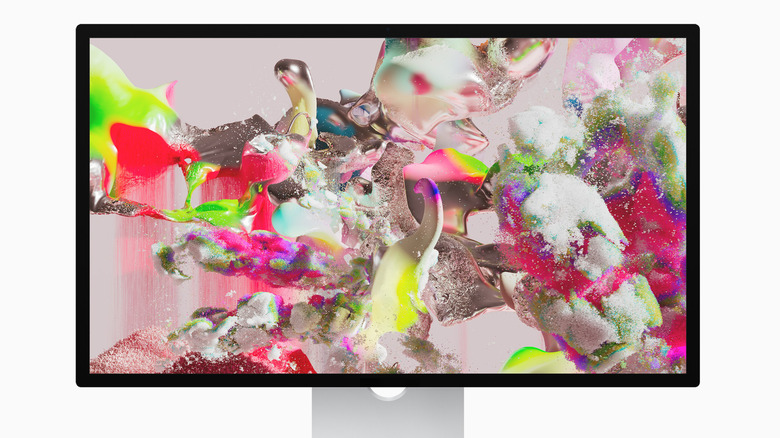This Apple Studio Display Teardown Raises A Fascinating Question
Earlier this month, Apple announced a bunch of new products, and in the wake of that reveal event, iFixit is having a grand old time by tearing all of them downs. First, we got to watch as iFixit took apart the Mac Studio, and now it's the new Apple Studio Display's turn. If you thought the Studio Display looks similar to the iMac, you certainly aren't alone there, as iFixit shares the sentiment.
However, iFixit's teardown found that the similarities are not just skin-deep. Not only is cracking open the Studio Display the same process as gaining access to the iMac, but the two even look similar on the inside. As you can see from the video below, even some of iFixit's tech experts couldn't tell which was the iMac and which was the Studio Display when comparing the two side-by-side, so Apple is definitely taking a page out of the iMac playbook with this new product. That realization begs the question: just how different are these two devices?
Studio Display teardown reveals some interesting components
While they're obviously different enough, considering one is a full-blown computer and the other is a display, iFixIt explains the process of getting into them is the same — which means taking off the Studio Display's screen is fraught with peril. The technicians have to slice through adhesive foam around the entire edge of the monitor's screen, and then they need to lift the display off using heavy-duty suction cups. As the Studio Display doesn't have any kind of chin to rest the screen on, anyone attempting ingress will want to lay the Studio Display down on its back before lifting the screen off.
Once inside, iFixit immediately goes for the Studio Display's underwhelming 12MP webcam and discovers that it mostly looks the same as an iPhone 11 front camera. That suggests the problems Studio Display users encountered aren't hardware-based, and with Apple working on a fix, there's at least a decent chance that camera quality won't be this disappointing forever.
This teardown also reveals a thin, multi-board internal power supply that takes up a lot of space and requires massive fans for cooling. According to iFixit, the internal power supply and its associated fans are the reason why the Studio Display is about 50% thicker than the iMac. So, even though this looks a lot like an iMac on the inside, it sounds like most of that has to do with the power supply and the fans needed to cool it. Of course, there's also the fact that the Studio Display uses an A13 chip and has 64GB of storage, technically making it an all-in-one computer even if it doesn't act like one.
Do we even want to know the repairability score?
Unfortunately, iFixit's teardown of the Studio Display doesn't have an associated repairability score for which the website has become known. Even if it did, we can't imagine it would be particularly great; not only does the Studio Display seem difficult to get into, but a lot of the components are held in place with security screws and glue. That's especially true with the Studio Display's speakers firmly stuck in position.
So, even though iFixit didn't give us a repairability score for the Studio Display, we're not holding out much hope for a repairable device here, especially when we consider that Apple has a history of making devices that aren't easily repaired by third-parties. The good news is that the Mac Studio is at least somewhat repairable, but of course, like most Apple products, it still has a long way to go before it can be considered truly DIY-friendly.

